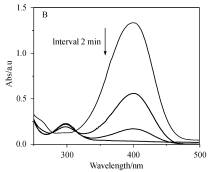化学学报 ›› 2011, Vol. 69 ›› Issue (9): 1060-1064. 上一篇 下一篇
研究论文
郭清华,韩三阳,姚建林*,顾仁敖
GUO Qing-Hua, HAN San-Yang, YAO Jian-Lin, GU Ren-Ao

采用水热方法分别合成了Fe3O4磁性内核以及Fe3O4@C粒子. 并原位合成了Fe3O4@C/Pt复合纳米结构, 采用SEM, TEM 红外光谱, Raman光谱等手段进行了相关表征. 研究了纯Pt纳米粒子以及Fe3O4@C/Pt复合纳米结构催化硼氢化钠(NaBH4)还原对硝基苯酚(4-NP)的反应活性, 并利用外加磁场富集的方式对该复合纳米结构催化剂进行回收和循环利用. 研究结果表明Fe3O4@C/Pt复合纳米结构的催化性能较纯Pt纳米粒子高, 这主要由于Fe3O4的协同效应所致, 即Fe3O4和Pt间的电荷转移致使Pt的催化活性提高. 该复合型催化剂可实现回收和循环利用, 其可循环利用次数约为20次.